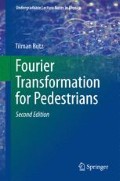Abstract
This chapter deals with the discrete Fourier transformation. Here, a periodic series in the time domain is mapped onto a periodic series in the frequency domain. Definitions of the discrete Fourier transformation and its inverse are given. Linearity, convolution, cross-correlation, and autocorrelation are treated as well as Parseval’s theorem. The sampling theorem is illustrated with a simple example. Data mirroring, cosine- and sine-transformations, as well as zero-padding are discussed. It concludes with the Fast Fourier Transformation algorithm by Cooley and Tukey.
Access this chapter
Tax calculation will be finalised at checkout
Purchases are for personal use only
Notes
- 1.
Programming languages such as, for example Turbo-Pascal, C, Fortran, ... feature random generators that can be called as functions. Their efficiency varies considerably.
Author information
Authors and Affiliations
Corresponding author
Playground
Playground
4.1
Correlated
What is the cross correlation of a series \(\{f_k\}\) with a constant series \(\{g_k\}\)? Sketch the procedure with Fourier transforms!
4.2
No Common Ground
Given is the series \(\{f_k\}=\{1,0,-1,0\}\) and the series \(\{g_k\}=\{1,-1,1,-1\}\).
Calculate the cross correlation of the two series.
4.3
Brotherly
Calculate the cross correlation of \(\{f_k\}=\{1,0,1,0\}\) and \(\{g_k\}=\{1,-1,1,-1\}\), use the Convolution Theorem .
4.4
Autocorrelated
Given is the series \(\{f_k\}=\{0, 1, 2, 3, 2, 1\}\), \(N=6\).
Calculate its autocorrelation function . Check your results by calculating the Fourier transform of \(f_k\) and of \(f_k\otimes f_k\).
4.5
Shifting around
Given the following input series (see Fig. 4.25):
-
a.
Is the series even , odd , or mixed ?
-
b.
What is the Fourier transform of this series?
-
c.
The discrete “\(\delta \)-function” now gets shifted to \(f_1\) (Fig. 4.26). Is the series even, odd, or mixed?
-
d.
What do we get for \(|F_j|^2\)?
4.6
Pure Noise
Given the random input series containing numbers between \(-0.5\) and \(0.5\).
-
a.
What does the Fourier transform of a random series look like (see Fig. 4.27)?
-
b.
How big is the noise power of the random series, defined as:
$$\begin{aligned} \sum _{j=0}^{N-1} |F_j|^2 ? \end{aligned}$$(4.57)Compare the result in the limiting case of \(N\rightarrow \infty \) to the signal power of the input \(0.5\cos \omega t\).
4.7
Pattern Recognition
Given a sum of cosine functions as input, with plenty of superimposed noise (Fig. 4.28):
where RND is a random numberFootnote 1 between \(0\) and \(1\).
How do you look for the pattern Fig. 4.29 that’s buried in the noise, if it represents the three cosine functions with the frequency ratios \(\omega _1:\omega _2:\omega _3=5:7:9\)?
Input function according to (4.58)
4.8
Go on the Ramp (for Gourmets only)
Given the input series:
Is this series even, odd, or mixed? Calculate the real and imaginary part of its Fourier transform. Check your results using Parseval’s theorem . Derive the results for \(\sum _{j=1}^{N-1}1/\sin ^2(\pi j/N)\) and \(\sum _{j=1}^{N-1}\cot ^2(\pi j/N)\).
4.9
Transcendental (for Gourmets only)
Given the input series (with \(N\) even!):
Is the series even, odd, or mixed? Calculate its Fourier transform. The double-sided ramp is a high-pass filter (cf. Sect. 5.2), which immediately becomes clear considering the periodic continuation. Use Parseval’s theorem to derive the result for \(\sum _{k=1}^{N/2} 1/\sin ^4(\pi (2k-1)/N)\). Use the fact that a high-pass does not transfer a constant in order to derive the result for \(\sum _{k=1}^{N/2} 1/\sin ^2(\pi (2k-1)/N)\).
Rights and permissions
Copyright information
© 2015 Springer International Publishing Switzerland
About this chapter
Cite this chapter
Butz, T. (2015). Discrete Fourier Transformation. In: Fourier Transformation for Pedestrians. Undergraduate Lecture Notes in Physics. Springer, Cham. https://doi.org/10.1007/978-3-319-16985-9_4
Download citation
DOI: https://doi.org/10.1007/978-3-319-16985-9_4
Published:
Publisher Name: Springer, Cham
Print ISBN: 978-3-319-16984-2
Online ISBN: 978-3-319-16985-9
eBook Packages: Physics and AstronomyPhysics and Astronomy (R0)






